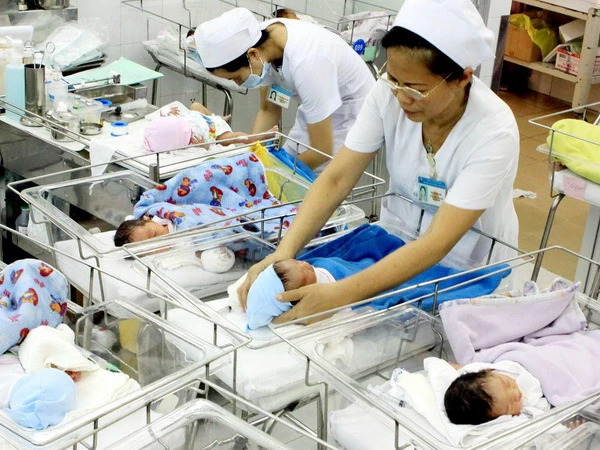 Society
Society

 |
| The recent statistics for 2023 reveal that each woman in Việt Nam now has 1.9 children on average, marking the lowest figure recorded. — VNA/VNS Photos |
HÀ NỘI — In recent years, Việt Nam has seen a drop birth rates, impacting population structure and size, leading to a shrinking workforce and accelerated ageing.
As per data from the General Statistics Office under the Ministry of Planning and Investment, the average number of children per woman of childbearing age in Việt Nam was 2.33 in 1999.
Since 2009, the birth rate has hovered around replacement level of 2.1 children, showing slight fluctuations.
However, the recent statistics for 2023 reveal that each woman in Việt Nam now has 1.9 children on average, marking the lowest figure recorded.
Việt Nam is currently grappling with specific challenges, particularly concerning the target for 2030, which aims to sustain a steady replacement fertility rate of 2.1 children per woman, while anticipating a population size of approximately 104 million people.
Population director Lê Thanh Dũng from the Ministry of Health explained that replacement fertility signifies the average number of children a woman has in her lifetime to sustain the population size. Once the total fertility rate hits 2.1 children per woman, it meets this replacement level.
A decline in fertility rates impacts various aspects including population size, age distribution, reduction in the working-age population, migration trends and acceleration of population aging. It also hampers the potential of demographic dividends.
Presently, there's a notable gap in fertility rates across different regions and provinces. Twenty-one provinces and cities exhibit low fertility rates, with some areas experiencing exceptionally low rates, particularly concentrated in the southeast, Mekong Delta, and central coastal regions.
The southeast region has witnessed a significant drop, from 2.9 children per woman in 1999 to a mere 1.56 children at present.
Low fertility isn't confined to urban areas with advanced economies but also prevalent in provinces grappling with economic and social challenges, such as the Mekong Delta region, pivotal in agricultural production and national food security.
Provinces with low fertility rates make up approximately 39.4 per cent of the national population, significantly influencing the country's path toward sustainable development, Dũng said.
According to Associate Professor Dr. Trần Thị Minh Thi, editor-in-chief of the Journal of Family and Gender Studies, countries like Japan, South Korea, and China, which share socio-cultural similarities with Việt Nam and prioritise cultural values and the significance of children and family, have all encountered the challenge of declining birth rates in recent years.
Despite numerous efforts to address this issue and increase birth rates, none has yielded successful results.
In recent years, the female labour force has seen a significant growth, making up over 70 per cent.
In Vietnamese culture, women often take on the primary caregiving role within families. Consequently, a declining birth rate will inevitably worsen these issues further.
Director Lê Thanh Dũng highlighted that beyond various factors contributing to declining birth rates, societal dynamics play a significant role. The rapid pace of urbanisation, combined with socio-economic growth, engulfs the younger generation in a relentless whirlwind of progress, leaving them little time for pause.
The challenges of finding suitable housing, managing family expenses, and covering the costs of raising children add significant pressures, leading to uncertainties regarding marriage and childbearing.
Urban areas, industrial zones, healthcare, social services, and educational facilities often face shortages and inadequacies. Despite population density calculations per district, the available services often remain insufficient to meet the needs of the residents.
The widespread occurrence of abortion in both public and private healthcare facilities persists as a problem lacking stringent control measures, potentially resulting in infertility or secondary infertility. Alongside the declining birth rate, the population's age distribution is shifting towards aging.
In 2019, the ratio was one elderly person for every two children; by 2069, this ratio is projected to shift to three people over 60 years old for every two children.
So Việt Nam will confront with two overarching challenges impacting socio-economic development: low birth rate and an aging population. The consequence of these challenges will have enduring effects on the lives of individuals, families, and society as a whole, he said.
Ensuring birth rate and future workforce
 |
| Promoting population education to every household in Yên Thắng Commune, Lục Yên District, Yên Bái Province. |
To address the disparities in birth rates among regions and uphold replacement-level fertility, Prime Minister Phạm Minh Chính approved the Birth Rate Adjustment Programme suitable for different regions and target groups by 2030.
The decision sets clear targets: increasing the total fertility rate by 10 per cent in low-birth-rate areas and reducing it by 10 per cent in high-birth-rate areas, while maintaining replacement-level fertility in other regions.
In addressing the declining birth rate, Mai Trung Sơn from the Population Department highlighted four proposed measures in the draft Population Law to encourage two-child families in areas with low birth rates.
These measures include offering one-time financial support for second-child births, reducing or exempting school fees, and aiding education expenses for young children.
Additionally, organisations, institutions, and businesses will provide counselling and family support services, taking advantage of encouraged healthcare policies.
The proposal also emphasises creating a supportive environment for couples to raise two children, ensuring proper childcare and shared family responsibilities. Employers are also urged to take social responsibility towards workers with young children.
Professor Nguyễn Đình Cử stressed the need for policy adjustments and flexible communication to address the declining birth rate.
Population policies should shift focus towards family planning rather than solely reducing births, requiring the removal of outdated policies. Tailored regional policies are necessary; areas with low birth rates should have specific measures, while those needing increased birth rates should relax regulations and encourage higher birth rates.
Sustaining a stable working-age population proportion will prolong the "golden population" phase and improve overall population quality.
Việt Nam is in the process of drafting the Population Law, a critical phase where researchers and policymakers need to consider population and development policies that positively impact future workforce issues and the nation's long-term sustainability. — VNS




